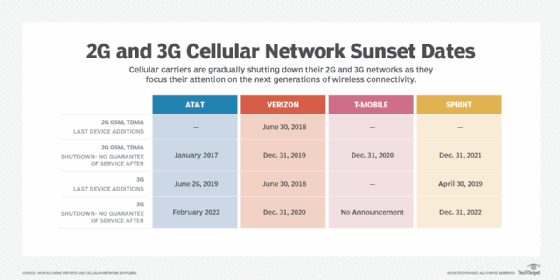
Nmedia - Fotolia
What do 2G and 3G sunset dates mean for business customers?
A 2G and 3G shutdown probably won't affect businesses much, but embedded IoT devices may see some problems as these two older cellular technologies fade away.
All good things must come to an end, including some cellular technologies. While many industry observers are focused on the leading edge of the cellular market, the here-and-now technologies are also important to watch. After all, cellular carriers do retire network standards periodically, but the upgrades are scheduled to minimize the effect on users.
While most cellular savants are focused on 5G, what will happen with older cellular standards, such as 2G and 3G? The shutdown, or sunset, dates for these technologies vary by carrier. Despite the noise that 5G has created, the 3G sunset date for AT&T, for example, is still two years away.
For businesses, the big question is: Do I need to worry about a 2G or 3G sunset date? For most customers, the answer is probably not.
Enterprise users depend on their mobile devices and update them regularly. By the time carriers sunset one of these technologies, the phones that depended on them can only be seen in old movies -- like Gordon Gekko's Motorola DynaTAC in the 1987 movie Wall Street.
Cellular shutdown could affect IoT devices
While most business customers may not have to worry about a 2G or 3G sunset, embedded IoT devices may create some problems. Certain service providers, such as OnStar, have modules installed in cars when they are built -- and those modules are often not upgradeable.
At some point, someone will realize cars last longer than cellphones, and that same upgrade hurdle will exist for fleet management modules and other IoT applications. Many of those systems chug along for years with nobody thinking about them until one day they stop sending back data.
All this reminiscing about 2G and 3G does point to the need for organizations -- particularly organizations that depend heavily on cellular technologies -- to stay up to date on cellular changes. Because, understandably, cellular carriers shouldn't continue to operate networks that have no demand.

Defaulting to newest network standards
Newer phones still support longstanding cellular standards. The chipset in your cellphone typically supports several different cellular specifications. The iPhone 11, for instance, supports the following standards:
- frequency-division duplex LTE (FDD-LTE) and time-division LTE (TD-LTE);
- code-division multiple access evolution-data optimized revision A (CDMA EV‑DO Rev. A);
- universal mobile telecommunications system evolved high-speed packet access (UMTS/HSPA+); and
- global system for mobile communications enhanced data for global evolution (GSM/EDGE).
Sometimes, reading these specs is like a trip down memory lane.
Even though the iPhone 11 has all those options available, it will default to the newest version that has a signal in the area. The device will always pick the newer options because they offer higher transmission rates and more bandwidth efficiency, which means how many bits it can send per cycle of radio frequency or spectrum.
With newer cellphones automatically opting for network access using the more recent network standards, a planned obsolescence, essentially, is expected for the superseded cellular standards. As carriers see less traffic on the older network services, they begin migrating those frequency channels for better use. They want to support the new stuff.
Cellular carrier engineers closely monitor how rapidly traffic moves onto the newer option. The channels that carry 2G and 3G services today will likely carry 5G in the near future.







